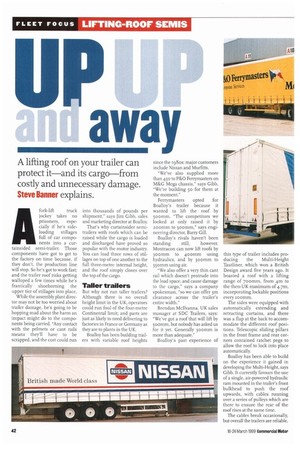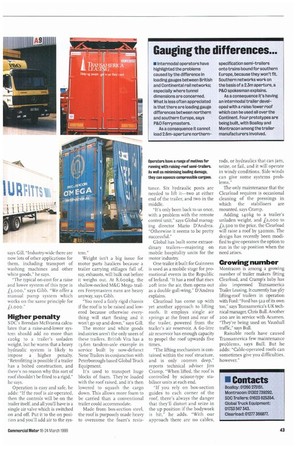A fork-lift truck jockey takes no prisoners, especially if he's sideloading
Page 44

Page 45

If you've noticed an error in this article please click here to report it so we can fix it.
stillages full of car components into a curtainsided semi-trailer. Those components have got to get to the factory on time because, if they don't, the production line will stop. So he's got to work fast; and the trailer roof risks getting walloped a few times while he's frantically shoehorning the upper tier of stillages into place.
While the assembly plant director may not be too worried about trailer damage, he's going to be hopping mad about the harm an impact might do to the components being carried. "Any contact with the pelmets or cant rails means they'll have to be scrapped, and the cost could run into thousands of pounds per shipment," says Jim Gibb, sales and marketing director at Boalloy.
That's why curtainsider semitrailers with roofs which can be raised while the cargo is loaded and discharged have proved so popular with the motor industry. You can load three rows of stillages on top of one another to the full three-metre internal height, and the roof simply closes over the top of the cargo.
Taller trailers
But why not run taller trailers? Although there is no overall height limit in the UK, operators could run foul of the four-metre Continental limit; and parts are just as likely to need delivering to factories in France or Germany as they are to plants in the UK.
Boalloy has been building trailers with variable roof heights since the 19805: major customers include Nissan and Murfitts.
"We've also supplied more than 450 to P&.0 Ferrymasters on M&G Mega chassis," says Gibb. "We're building 5o for them at the moment."
Ferrymasters opted for Boalloy's trailer because it wanted to lift the roof by 500mm. "The competitors we looked at only raised it by 200MM to 300mm," says engineering director, Barry Gill.
Boalloy's rivals haven't been standing still, however. Montracon can now lift roofs by 3 oo mm to 400mm using hydraulics, and by 3oomm to 55 omm using air.
"We also offer a very thin cant rail which doesn't protrude into the load space, and cause damage to the cargo," says a company spokesman, "so we can offer 3m clearance across the trailer's entire width."
Brendan McIlvanna, UK sales manager at SDC Trailers, says: "We've got a roof that will lift by 500mm, but nobody has asked us for it yet. Generally 3oomm is more than adequate."
Boalloy's past experience of this type of trailer includes producing the Multi-Height Tautliner, which won a British Design award five years ago. It boasted a roof with a lifting range of 700mm, from 4m to the then-UK maximum of 4.7m, incorporating lockable positions every ioomm.
The sides were equipped with automatically extending and retracting curtains, and there was a flap at the back to accommodate the different roof positions. Telescopic sliding pillars in the front frame and rear corners contained ratchet pegs to allow the roof to lock into place automatically.
Boalloy has been able to build on the experience it gained in developing the Multi-Height, says Gibb. It currently favours the use of a single, air-powered hydraulic ram mounted in the trailer's front bulkhead to push the roof upwards, with cables running over a series of pulleys which are there to ensure the rear of the roof rises at the same time.
The cables break occasionally, but overall the trailers are reliable,
says Gill. "Industry-wide there arc now lots of other applications for them, including transport of washing machines and other white goods," he says.
"The typical on-cost for a raise and lower system of this type is 3,0oo," says Gibb. "We offer a manual pump system which works on the same principle for fi,000."
Higher penalty
S DC's Brendan Maya nna calc-ula tes that a raise-and-lower system should add no more than 120kg to a trailer's unladen weight, but he warns that a heavy hydraulic system is likely to impose a higher penalty. "Retrofitting is possible if a trailer has a bolted construction, and there's no reason why this sort of roof shouldn't be fitted to a rigid," he says.
Operation is easy and safe, he adds: 'If the roof is air-operated, then the controls will be on the trailer itself, and all you'll have is a single air valve which is switched on and off. Put it to the on position and you'll add air to the sys
Weight isn't a big issue for motor parts hauliers because a trailer carrying stillages full of, say, exhausts, will bulk out before it weighs out. At 8,600kg, the shallow-necked M&G Megatrailers Ferrymasters runs are heavy anyway, says Gibb.
"You need a fairly rigid chassis if the roof is to be raised and lowered because otherwise everything will start flexing and it won't go up and down," says Gill,
The motor and white goods industries aren't the only users of these trailers. British Vita has a 13.6m tandem-axle example in service built by now-defunct Nene Trailers in conjunction with Peterborough-based Global Truck Equipment.
It's used to transport huge blocks of foam. They're loaded with the roof raised, and it's then lowered to squash the cargo down. This allows more foam to be carried than a conventional trailer could accommodate.
Made from box-section steel, the roof is purposely made heavy to overcome the foam's resis
tance. Six hydraulic posts are needed to lift it—two at either end of the trailer, and two in the middle.
"It's only been back to us once, with a problem with the remote control unit," says Global managing director Mario D'Andrea. "Otherwise it seems to be pretty successful."
Global has built some extraordinary trailers—majoring on mobile hospitality units for the motor industry.
One trailer it built for Guinness is used as a mobile stage for promotional events in the Republic of Ireland. "It has a roof that rises 2oft into the air, then opens out as a double gull-wing," D'Andrea explains.
Clearload has come up with yet another approach to lifting roofs. It employs single air springs at the front and rear of the trailer, powered from the trailer's air reservoir. A Go-litre air reservoir has enough capacity to propel the roof upwards five times.
"The lifting mechanism is contained within the roof structure, and is only ioomm deep," reports technical adviser Jim Cramp. "When lifted, the roof is controlled by scissor-type stabiliser units at each end.
"If you rely on box-section guides to each corner of the roof, there's always the danger that they'll distort and seize in the up position if the bodywork is hit," he adds. "With our approach there are no cables, rods, or hydraulics that can jam, seize, or fail, and it will operate in windy conditions. Side winds can give some systems problems."
The only maintenance that the Clearload requires is occasional cleaning of the pressings in which the stabilisers are mounted, says Cramp.
Adding 140kg to a trailer's unladen weight, and 12,000 to £2,500 to the price, the Clearload will raise a roof by 320mm. The design has recently been modified to give operators the option to run in the up position when the need arises.
Crowing number
Montracon is among a growing number of trailer makers fitting Clearload, and Cramp's baby has also impressed Transamerica Trailer Leasing. It currently has 367 lifting-roof trailers in operation with Ford: "Ford has 522 of its own too," says Transamerica's UK technical manager, Chris Bull. Another 200 are in service with Acumen. "They're being used on Vauxhall traffic," says Bull.
Raisable roofs have caused Transamerica few maintenance problems, says Bull. But he adds: "Cable-operated roofs can sometimes give you difficulties, however."




















































































































